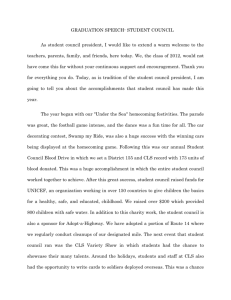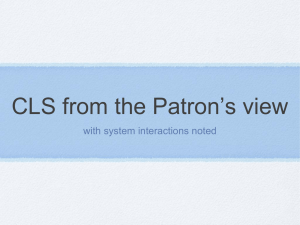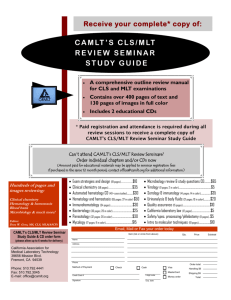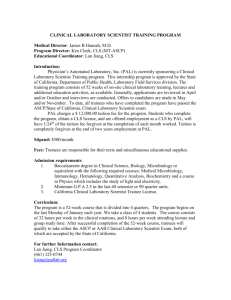AFME
advertisement
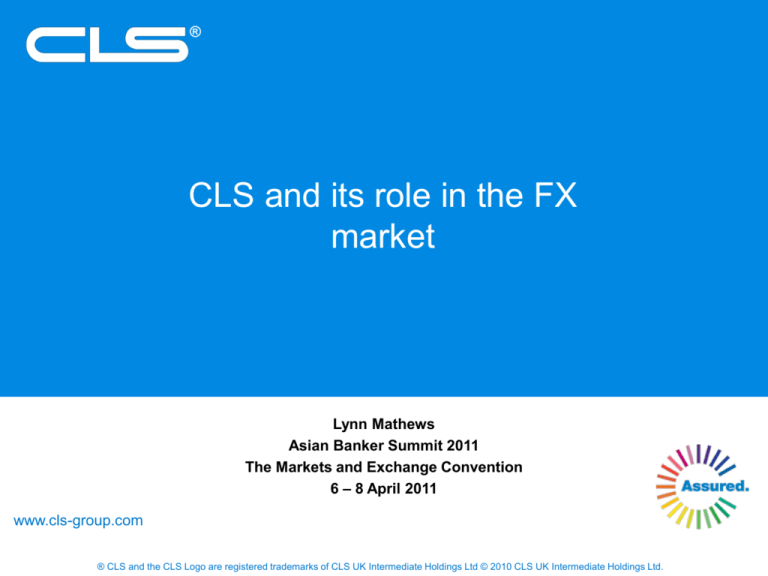
® CLS and its role in the FX market Lynn Mathews Asian Banker Summit 2011 The Markets and Exchange Convention 6 – 8 April 2011 www.cls-group.com ® CLS and the CLS Logo are registered trademarks of CLS UK Intermediate Holdings Ltd © 2010 CLS UK Intermediate Holdings Ltd. Agenda » FX market developments » CLS and its role in the FX market » Expanding the footprint of settlement risk elimination » Future challenges 2 FX market developments 3 FX market developments » Major financial crisis » Structural reforms underway – including derivatives markets » Credit and liquidity management disciplines re-visited » Increased capital requirements - Basel III » For FX, a trading revolution has taken place over the last five years » Automated trading and multi-function algorithms deployed » Significant decline in average trade size » Development and deployment of increasingly sophisticated trading platforms 4 FX market developments » Growth in value and change in market composition continues » FX is largest financial market: US$4 trillion traded per day1 » 65% of all FX transactions are cross-border1 » Trading with “other financial institutions” grew by 41%1 • Hedge funds, pension funds and mutual funds, insurance companies and retail Continuing increase in lower value trades - over 80% of CLS daily volumes » » Concentrated in major centres and currency pairs » Top six pairs account for 66% of daily turnover1 » USD/EUR, USD/Yen, USD/GBP, USD/AUD, USD/CAD, USD,CHF *Source: Bank for International Settlements Triennial Central Bank Survey – Foreign exchange and derivatives market activity in April 2010 (1 September 2010) (BIS) 5 CLS and its role in the FX market 6 CLS: fundamental to FX » Eliminates FX settlement risk » Minimises liquidity required to settle - reduced by 98% » Settling 58% of the daily market value settled externally, 68% of the accessible market, 90% of the interdealer market » Standard legal framework and operating rules » Unique oversight arrangement with 22 central banks » Owned by the major FX banks from around the world » Passed the test during the financial crisis » Week of 15 September 2008 - settled 4.4 million instructions and US$26.5 trillion *Source: Bank for International Settlements Triennial Central Bank Survey – Foreign exchange and derivatives market activity in April 2010 (1 September 2010) (BIS) All other data - CLS 2010 7 FX market with CLS today Major risk categories in FX have largely been addressed: » Settlement risk reduction — settlement risk is 89% of FX trade risk* » Liquidity risk — liquidity requirements reduced by 98% daily » Credit risk — FX market is short term, >75% of CLS trades settle in four months or less » Operational risk — global standards improve operational performance » CLS works with FX committees » Legal risk — standard legal framework and operating rules » FX trade information centralised The major risk mitigant in FX is CLS A proven infrastructure for the global FX market *Source: Oliver Wyman/AFME 2010. All other data — CLS 2010 8 History of CLS 1970s 1990s Allsopp Report / BIS - CPSS Bankhaus Herstatt fails 2002 CLS goes live 2005 Attains “market standard” 2008 2010s CPSS progress report Legal and regulatory changes to OTC Financial crisis 2010 BIS FX Survey issued Leading FX banks develop concept 2002 currencies: AUD, CAD, EUR, JPY, CHF, GBP, USD 2003 currencies: DKK, NOK, SEK, SGD, 2004 currencies: HKD, KRW, NZD, ZAR 2008 currencies: MXN, ILS 9 Settlement accounts with 17 central banks Settles 17 currencies, accounting for 94%* of daily traded value *Source: BIS Triennial Central Bank Survey – Foreign exchange and derivatives market activity in April 2010, 1 September 2010 10 Expanding the footprint of settlement risk elimination 11 No correlation between GDP and FX trading activity As economies develop, income per capita rises and the trading profile of FX changes: » Trading becomes more financial – “financialisation” » Trading moves beyond underlying current account transactions » Trading moves offshore – “internationalisation” » BIS 2010 survey found some currencies traded offshore to a greater extent than market participants had estimated (e.g. India, China) » The higher the difference between a currency's interest rates and the norm in the developed world, the higher the growth rate in trading – the carry trade 1BIS Quarterly Review, March 2011 12 Benefits of currency inclusion in CLS » Enhances financial stability through elimination of FX settlement risk for banks and local currency » Improves local oversight of the global FX market’s trading in the local currency » Minimises local currency funding for FX settlement but requires timed payments » Supports market growth through reduced credit needs » Delivers STP efficiency through implementation of world class standards » Business development opportunities for domestic banks » Central banks join the CLS Oversight Committee when their currencies are approved for settlement in CLS » Membership of a unique industry alliance 13 Benefits for investment managers » Oversight of settlement throughout the trade lifecycle: » Resolution of problems prior to settlement date » Settlement completed or your principal back » Increased operational efficiency and cost savings » Elimination of fails, compensation claims and interest charges » Enhanced STP » Reduced number of settlements and associated costs » Efficient allocation of monetary and physical resources » Improved liquidity management » Settlement risk elimination reduces credit barriers to trading » Competitive positioning/ business opportunities » Regulatory and fiduciary compliance 14 Future challenges 15 FX market future challenges - regulation » Review of OTC derivatives market underway - Dodd-Frank, US and European Markets Infrastructure Regulation (EMIR), EU » Impact on FX market unknown — two areas affect CLS: » Transparency » Mandated clearing » Acknowledgement that settlement risk remains the biggest risk in FX1 1 Oliver Wyman/AFME 2010 Settlement risk reduction 16 Thank you 17
